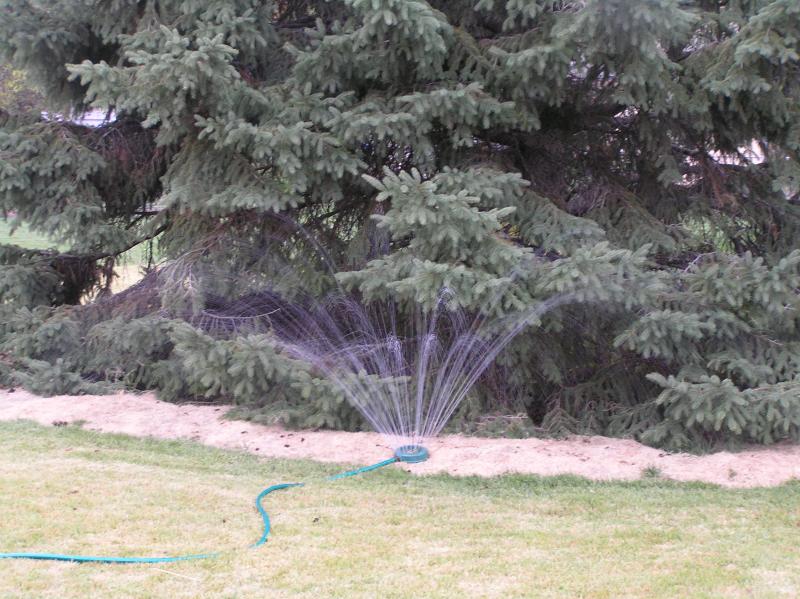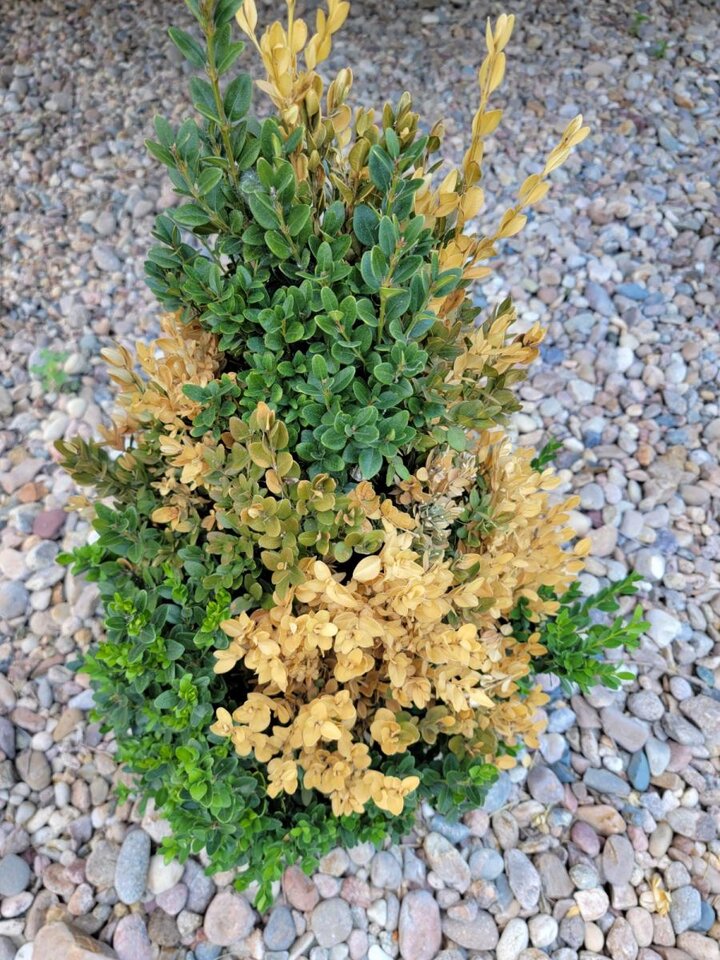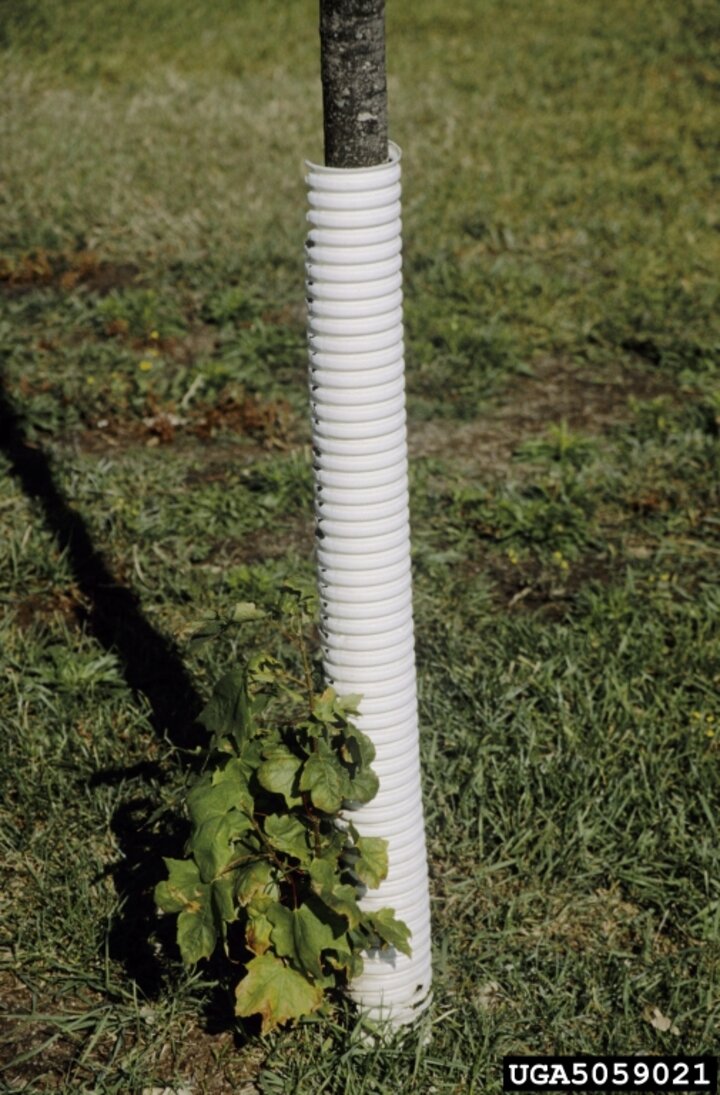Sarah Browning, Nebraska Extension Educator

The key to preventing winter desiccation is to keep plants well-watered throughout fall and into winter. Image by Sarah Browning, Nebraska Extension
Cold temperatures, drying sun and wind, road salt, snow and ice can all take a toll on landscape plants during winter. But homeowners can use the strategies below to prevent major damage and minimize winter’s toll. Now, while daytime temperatures are still fairly warm, is the time to prepare your plants for winter.
Fall Watering

The key to preventing winter desiccation is to keep plants well-watered throughout fall and into winter.
Provide woody landscape plants with at least one deep soaking per month in November and December. Apply water deeply, moistening the soil to a depth of 12 to 18-inches. Use a long-bladed screwdriver or piece of rebar to check the depth of water penetration. Once you've reached dry soil, it will be much harder to push the probe into the ground. Water the entire area underneath the tree’s drip line at a minimum, but even further out if possible.
To make the irrigation of your woody plants more effective, conserve soil moisture by applying a 3 to 6-foot diameter ring of mulch around the base of trees and shrubs. Use 3-4 inches of an organic material, like coarse wood chips, to help conserve soil moisture. Apply the mulch in a wide, flat layer like a pancake, not piled up like a mulch-volcano. Keep it a few inches away from the tree's bark to prevent bark rots.
Shade the Bark

Sunscald damage is usually not apparent until the following growing season when it appears as elongated dead patches of bark. These patches are often discolored - lighter or darker than nearby living bark. Eventually cracks form around the dead section, or through the middle of it, and the dead bark will peel away leaving the inner wood exposed.
Sunscald can be prevented in several ways, which all are intended to shade the south and west face of a young tree's trunk. Trees may need to be protected for several years until the bark is no longer smooth and thin.
- Apply white paint to a piece of wood and pound it into the ground on the south or southwest side of the tree to shade the trunk.
- Orchardists often apply whitewash or white latex paint directly to the trunks of young fruit trees in their orchards to reflect winter sunlight and keep the bark cooler.
- Commercial tree wraps made of brown paper are effective. Apply the wrap in late October or early November, but do not attach it directly to the tree. Remove the wrap each spring.
- White plastic tree guards can also be used.
Prevent Physical Damage
The weight of wet snow and ice on tree limbs and shrub branches can lead to limb breakage. It can also cause less obvious internal splits or cracks in trunks and limbs, which pose a risk long after the storm.
Arborvitae and pyramidal yew are two common shrubs which benefit from additional protection. One method which protects branches from breaking under heavy snow load is tying up each individual plant with heavy 3-strand jute twine. Start by tying the jute twine around the trunk at the base of the branches or to the base of one of the lower branches. Next, wrap the twine spirally up the plant, pulling the branches inward into a tight pyramidal shape. Just don't pull the twine so tightly that you break any branches.
The tighter conical shape created , and extra support provided by the jute twine, helps plants shed snow more easily and prevents branch damage. Remove the twine in spring after danger of snow has passed. As the weather warms, branches will move back to their normal position.
When a heavy snow or ice load does occur, whether the plant has been tied up or not, let the ice melt naturally from tree limbs. If it is safe to do so, gently remove snow from limbs with a broom or rake. Hold onto the limb from below and gently brush off loose snow. Do not hit a branch to knock off snow or ice. Watch for falling limbs and ice from above. Do not try to dig snow away from shrubs as this leads to damaged limbs.
Plant Selection
Once fully dormant, plants have a built-in ability to withstand temperatures down to a certain level. This is the basis of the U.S. Department of Agriculture's hardiness zones, those maps in the plant catalogs which divide the country into regions where various plants can be expected to survive a normal winter -- or not.
A good strategy when selecting plants is to choose those that are hardy in your zone or the next one north. You may get away with plants from warmer zones for a while, especially if you're blessed with a series of mild winters or you plant in a very protected area in which to plant, but the odds are that you'll lose those tender plants to cold injury sooner or later.
Don’t let the pretty pictures in garden catalogs entice you into choosing plants which will not be reliably winter hardy in your landscape! Check each plant’s hardiness zone recommendation before purchasing.
Image:
- Evergreens, including broadleaf evergreens like boxwood, are very susceptible to winter desiccation injury. Image from Sarah Browning, Nebraska Extension
- White plastic tree guards can be used to prevent sunscald. Image by Joseph O'Brien, USDA Forest Service, Bugwood.org.
Search Our Archive
Associated Video
Fall Tree Watering
UNL East Campus Landscape Services Manager Jeff Culbertson talks about the importance of keeping trees well watered this fall